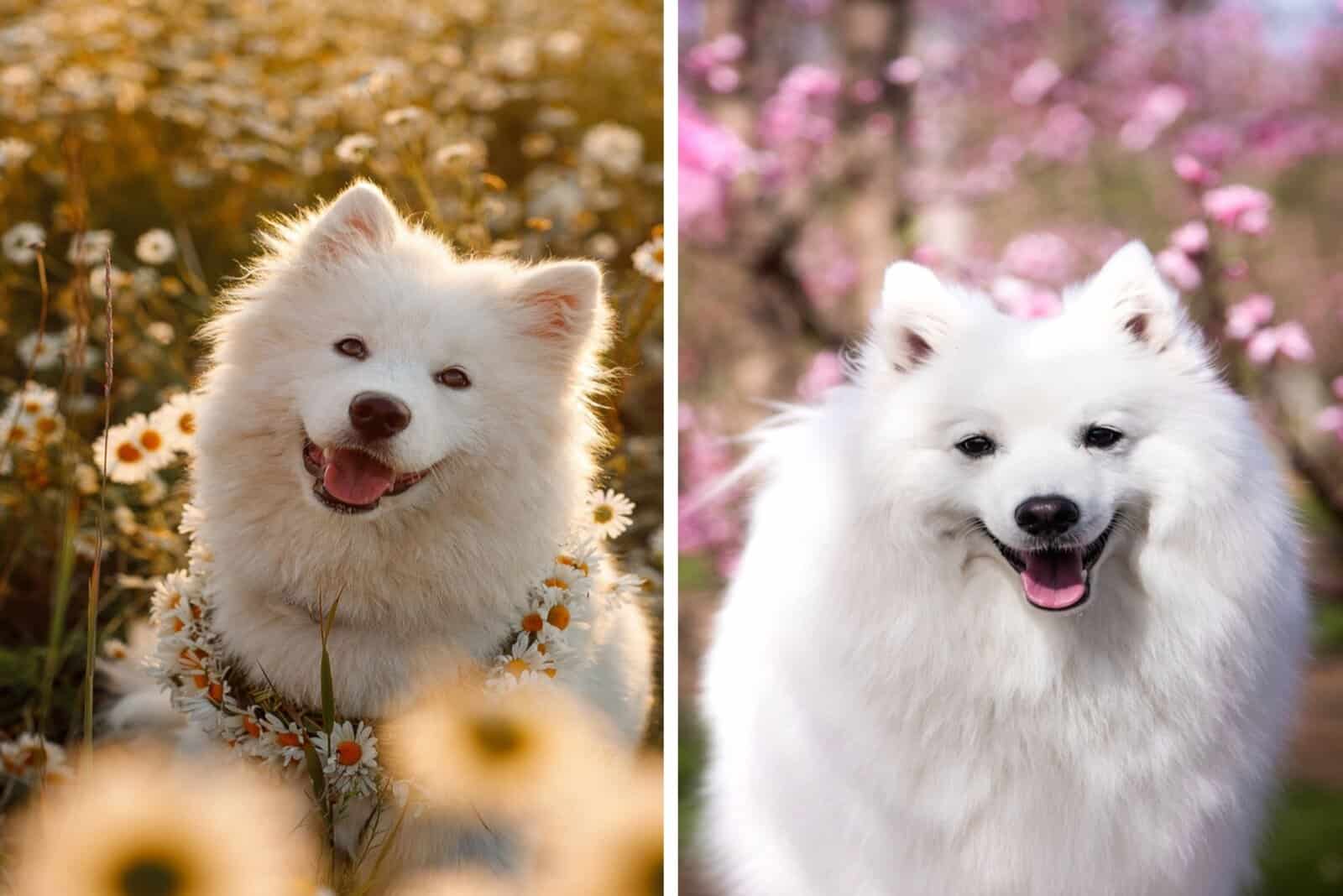It’s probably safe to say that anyone reading this is a big fan of fluffy, white, smiling dogs. There is something about the Japanese Spitz and the Samoyed, both of these dog breeds make wonderful pets, however, for very different owners.
The Samoyed and the Japanese Spitz are both wonderful, white, and fluffy cousin breeds, but which is the best? Both of the breeds are recognized by the American Kennel Club (AKC), however, the Japanese Spitz is not officially registered as a dedicated purebred.
Nonetheless, that doesn’t mean that one is more worthy than the other. Surely there are some differences in size, color, trainability, exercise needs, and so on.
To help you choose, we’re going to research both breeds and see what we can discover.
As well as looking at the Japanese Spitz vs. Samoyed, we’ll try to answer any questions that may arise along the way.
Japanese Spitz Vs. Samoyed: Temperament
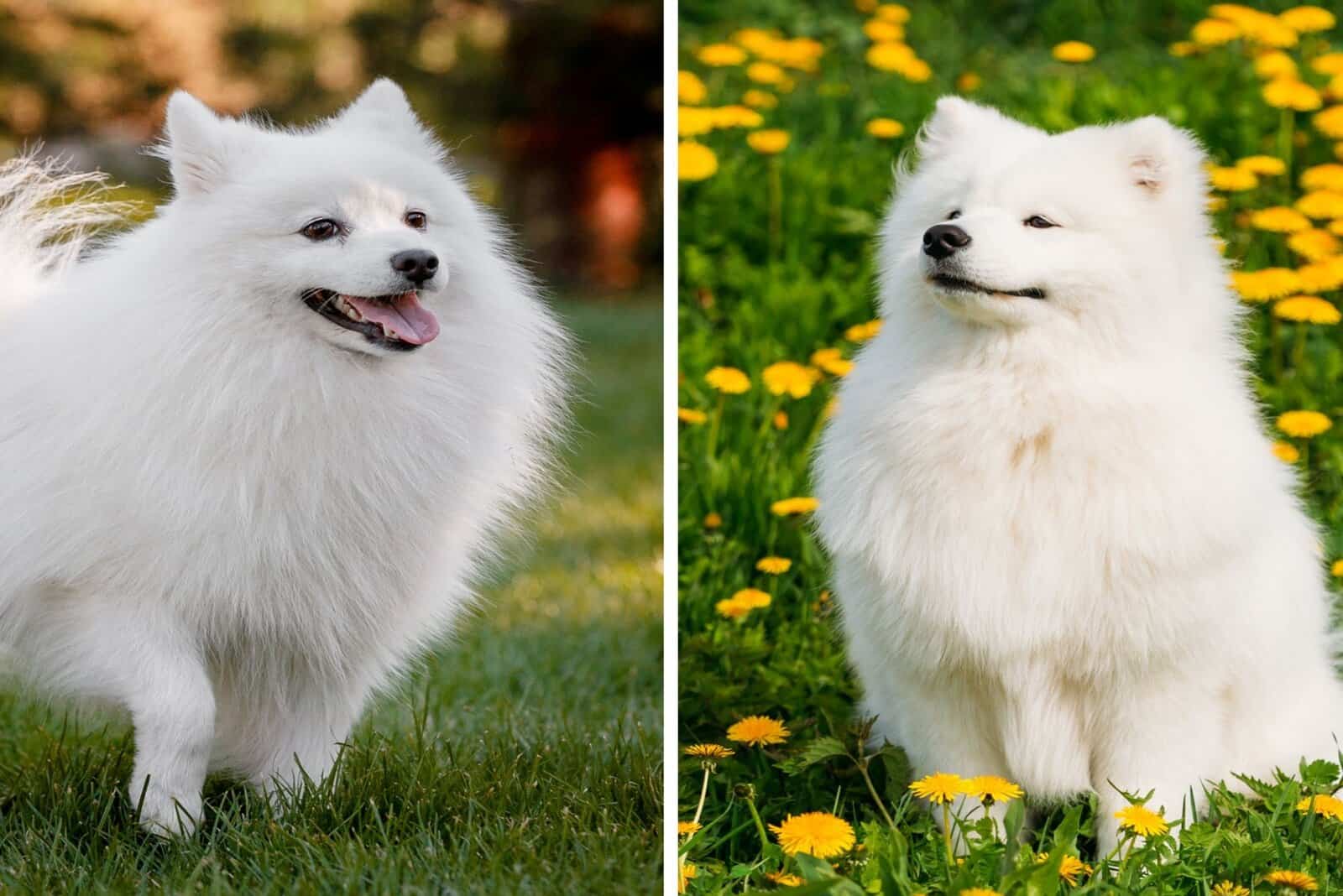
Both of these dog breeds are known as very gregarious and friendly dogs. Although Samoyeds are working dogs as well as good watchdogs, Japanese Spitzs are more of a companion dog. Either of them would make an effective guard dog.
Both the Japanese Spitz and the Samoyed do well with other dog breeds, this is important as they are large and some of them have a prey drive.
However, let us examine their temperaments in depth!
Japanese Spitz
Japanese Spitz dogs are dogs that always seem to wear a smile. No wonder, because their cute expressions match their happy personalities.
This breed of dog is intelligent, low-maintenance, easy to train, and wonderful with children. They can be good apartment dogs if their owner meets their exercise needs, daily walks are great for them.
Japanese Spitzs have a loving and devoted nature, but they are huge attention-seekers, so they don’t like being ignored. You can expect a lot of silliness from them, and when you leave them alone for hours, you can be sure that you’ll see their memorable mark – chewing your favorite shoe as a result of their “I’m alone” anxiety.
As they are very alert and intelligent, it is easy to train them. They thrive on positive reinforcement and structured activities, as they are eager to please and have great attention to detail.
Thanks to their intelligence, it is easy for them to invent mischief, like teaching themselves tricks that you won’t necessarily be happy to see. However, if you train them properly and consistently, this can be prevented.
Japanese Spitzs can be a bit reserved when they first meet with strangers, but with good socialization, their hearts melt.
You wouldn’t believe a small dog has such a bold bark. However, strangers can trigger their bark, but with reassurance from the pack, he is bold again. You can expect that this dog will be loyal to you no matter what.
When a dog owner has new visitors, it is best that he introduces his Japanese Spitz to them, so his friendly nature can shine.
Samoyed
With a Samoyed, you will have a dog companion that pushes you to do more and better. This challenging dog breed will give you a beautiful and unexpected friendship.
The Samoyed will encourage their owners and family, basically anyone he loves, to bike, run, hike, fetch, snowshoe, and play many games all day. He just loves to have fun. Imagine a gym coach in your life, that’s the kind of life coach a Samoyed is, a snowy and fluffy “let’s move” coach!
As these dogs were bred to work in the Arctic, it’s in their nature to handle more extreme sports, like skijoring, sledding, skiing, and various agility games. If your Sammie is cleared for health, why not stimulate him physically and mentally in these ways that are meant for him?
A Samoyed thrives when you give him task-oriented activities, it makes him happy when he needs to focus on something, and plus, he doesn’t want to be bored all the time. And, you definitely don’t want your Sammie to be bored, as he can be finicky, get into trouble, and even pluck out his fur if he’s stressed.
Sammie is a true family dog, he loves to herd children around and he is always eager to play outdoors. However, if you need your Sammie to be a snuggle buddy, say no more. He will gladly become a calm, gentle pillow that enjoys being with his family.
He has an alert attitude, which just means that he’s always looking out for his loved ones, and if he barks, he wants to let you know that something’s up.
If you encourage socialization skills when he’s little, he will be friendly and welcome anyone passing by. The Samoyed, by nature, is not considered aggressive at all.
Your Sammie can also have a special purpose in life, he can be a wonderful therapy dog. As he has a gentle demeanor, he will melt hearts at the care centers, giving hugs to the residents.
Even when he is young, he is eager to connect, so make sure that you introduce all the members of your group to your Sammie as soon as possible, especially children, other dogs, cats, and your friends. If you decide to get yourself a Samoyed, make sure that you fulfill your dog’s needs so he can thrive!
I have a 7 year-old niece that has a Samoyed named Penny, and let me tell you, I can’t decide who loves whom more.
Japanese Spitz Vs. Samoyed: Size
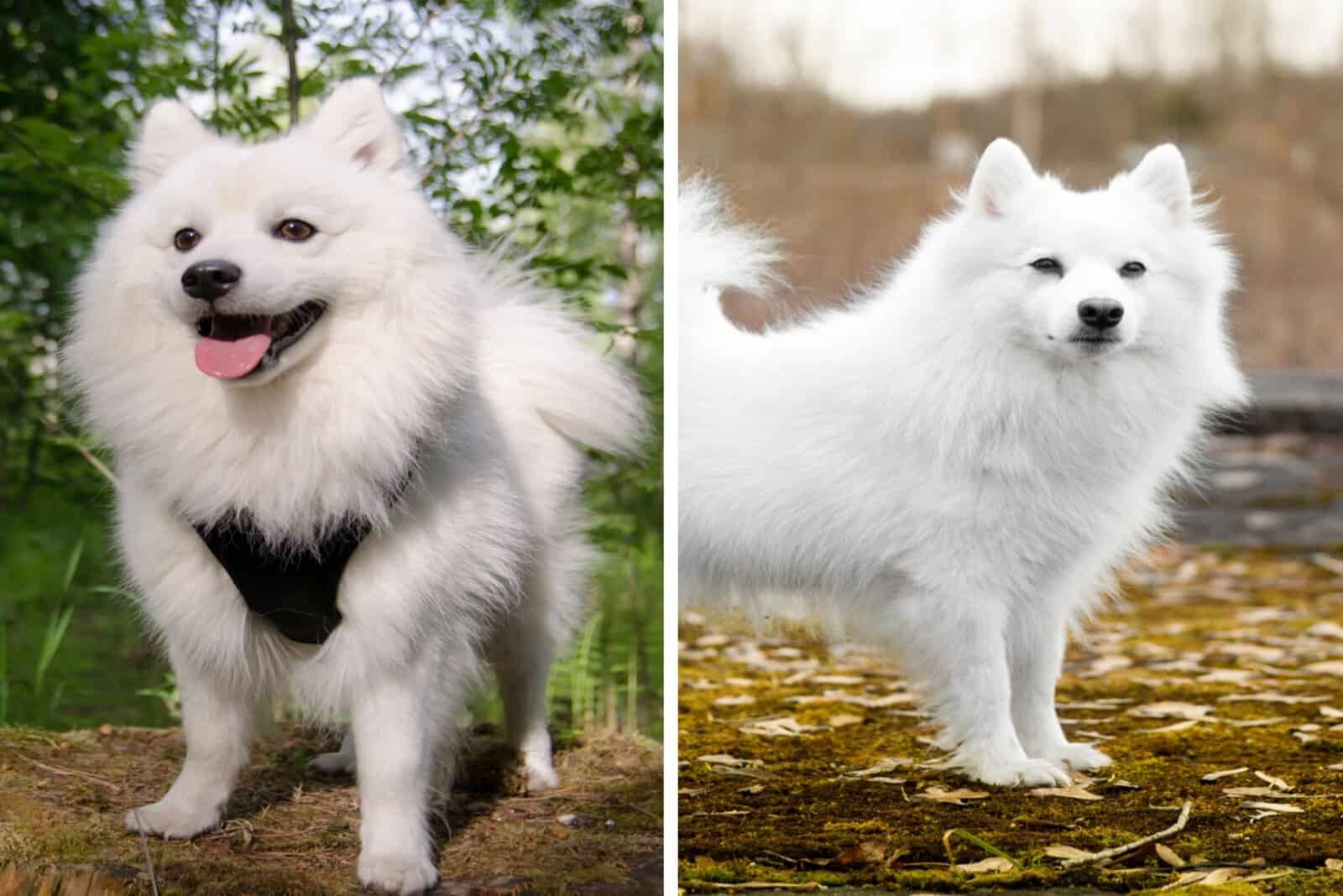
Japanese Spitz
Japanese Spitzs measure between 12 and 15 inches or 30 and 38 cm at the shoulder. As with all breeds, you’ll occasionally find those that fall outside these standard measurements.
They usually weigh between 11 and 20 pounds or 5 and 10 kg, and of course, the females’ height and weight is a bit smaller than the males’.
Samoyed
By contrast, Samoyeds measure between 21 and 23.5 inches (53-60 cm). They are a bit bigger than Japanese Spitzs.
Their usual weight is between 45 and 65 pounds (20.5-30 kg). As with other dog breeds, the females’ size is a bit different. We can see that the weight and height of the Samoyed is almost double the size of a Japanese Spitz.
You can check the Samoyed growth chart to see just how big they can get!
Japanese Spitz Vs. Samoyed: Exercise
Japanese Spitz
These dogs are highly adaptable. They need to get a good run and stretch their legs in order to be satisfied. They are always up to some games. A Japanese Spitz can accommodate himself, whether living in a small apartment or a big house with a huge yard.
They are energetic and quite easy to train, they aren’t fussy about small spaces and they take pride in being impressive agility and coordination competitors.
Japanese Spitzs are dedicated companions that require a large amount of attention and plenty of exercise. For them, a great exercise is to let them run free across the park or your yard with their fellow canines.
Even though a Japanese Spitz may be anxious when you leave them alone, they thrive when they are surrounded by their loving family members. Bear in mind that their small size does them a great favor, as you can take them with you when going on a day hike, running errands, or if your family have decided to go on a get-away camping trip.
To their owners, they can offer nothing but loyalty and affection. As ideal companion dogs, their gentle but playful nature makes them wonderful friends for children and adults, as well as other dogs and animals.
Samoyed
On the other side, we have Samoyeds with their high energy levels. They are a bit more energetic than the Japanese Spitz and they require more investment into their exercise, as they are larger.
Their mischievous and clever nature comes in handy when they need to solve a problem in the wild, however, this is not so suitable in your backyard. Many arctic dogs have instinctual digging habits and, so does the Sammie.
They can dig holes in your backyard and I’m sure you don’t want that. You can try to structure their play and set a date and place for allowed digging, for example in the woods, on a beach, or at a dog park. You can also try to make him his own personal play space in your yard. You’ll need to give him some treats in order to condition him to just play in that area.
Their high energy levels require strong and firm exercise a few times a day. Keep in mind that Samoyeds thrive in outdoor activities, so if you are to own this dog, let him be. He will be much happier and healthier.
The Samoyed needs an owner who can keep up with his energetic temperament. He enjoys giving chase, which includes smaller pooches, backyard wildlife, and racing after cars. In situations like these, you might need to intervene. This dog would be satisfied if a medium to large dog of the opposite sex came and played with them.
Generally, Samoyeds want to please their owners, however, their independent spirit can often come to the surface if you don’t assert your role as the one in charge. They are strong willed and you need to approach them with positive reinforcement. They don’t need to be scared of you, but you need to be firm, consistent, and to spice it up, loving.
It’s good to continue, from time to time, to bring a behaviorist to your home, even after puppy training so you can both learn new stuff.
Proper training is also great because it helps with productive vocalization. What does this mean? It means that when your Sammie talks to you in woofs, snorts, and yips, it can be dramatic, and there is a huge chance that you won’t like it and neither will your neighbors.
According to the Samoyed Club of America, you need to give your dog treats and be onboard with teaching the value of “quiet” and “settle”.
Japanese Spitz Vs. Samoyed: Health
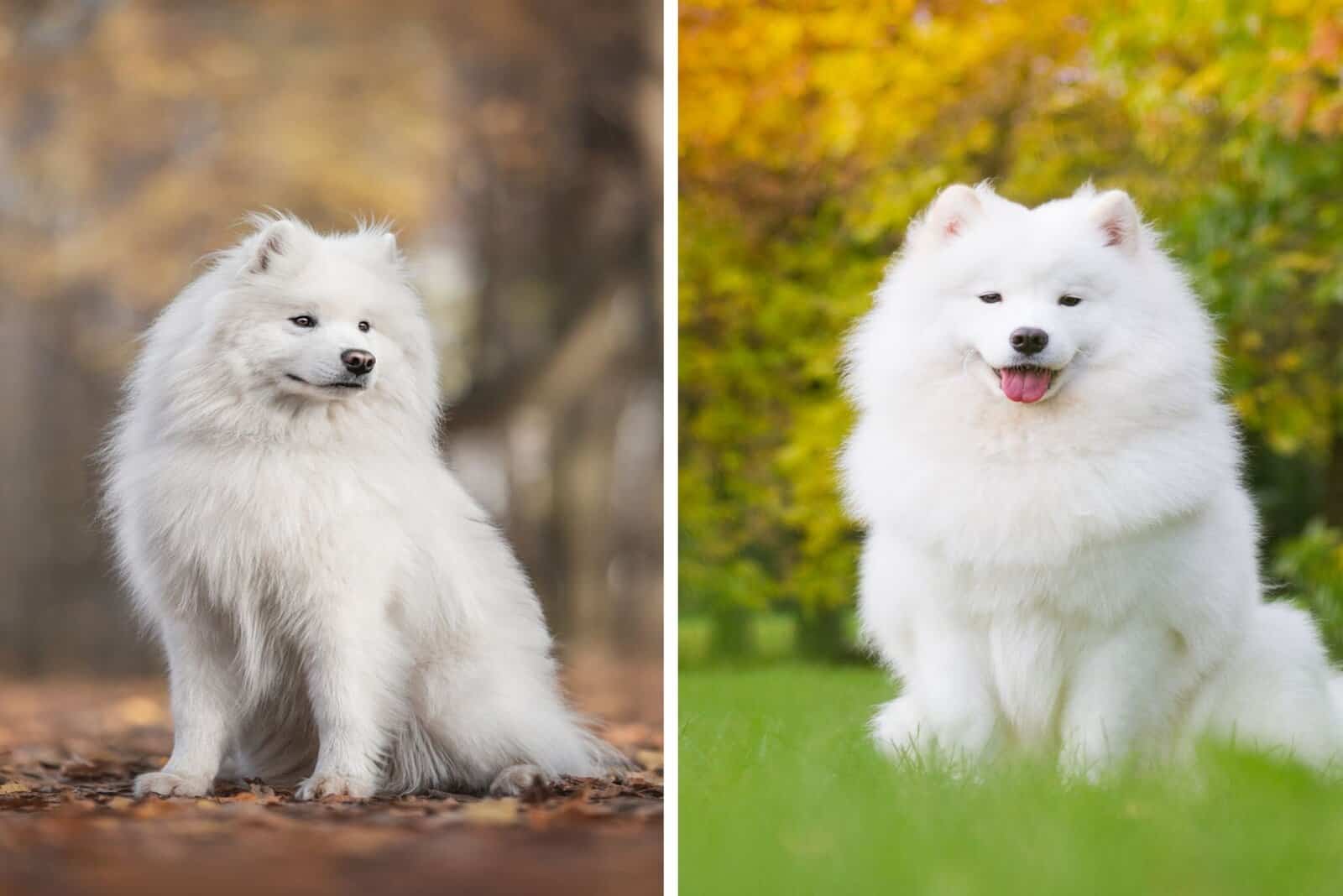
Sadly, all dogs face common health problems, some more than others. So, in our Japanese Spitz vs. Samoyed study, we’ve explored the sorts of sickness and diseases we should expect.
Japanese Spitz
Generally, the Japanese Spitz breed is considered one of the healthiest dog breeds, according to Georgina Ushi who is a medical director at Pet Urgent Care at Wesley Chapel.
However, they may sometimes have some health issues, such as:
• The patellar luxation – Their kneecaps can dislocate or move from their usual positioning and cause osteoarthritis.
• Runny eyes – This can be easily solved, just clean and wipe away any discharge gently with a cloth and warm water.
• Dry and itchy skin – Their skin may become dry and itchy if they are bathed too often, so keep in mind that you only need to bathe your dog when it is really necessary.
Also, they may become obese if they are constantly fed with unhealthy food or too much treats.
Samoyed
Most Samoyeds are powerful and have only a few health issues. But, being sled dogs, they are prone to some genetic conditions:
• Hip dysplasia – This is a genetic orthopedic condition that causes bone degeneration, pain, and arthritis. If this isn’t too serious, a veterinarian can treat the condition with medications and joint health supplements, but if it’s already progressed, surgery is necessary.
• Glomerulopathy – Type of kidney disease
• Diabetes
• Skin problems
• Overheating – In warmer climates, your Sammie can overheat, so you need to watch out for how long they are outside playing. It’s best, if you notice that it is hot and humid to you, to not let them outside until the temperature goes down. In hot months, you should plan their exercise time early in the morning or later in the evening, so your friend doesn’t feel uncomfortable.
You should also watch out for a Samoyed’s weight, as we already said.
Japanese Spitz Vs. Samoyed: Lifespan
It’s not comforting when you see that some dog breeds have longer lives than your dog breed. A relatively healthy Chihuahua can live for up to 20 years, while a Golden Retriever or Cane Corso will usually live for between 10 and 12 years.
However, our two dog breeds that we’re studying today have relatively long lifespans. Let’s see!
Japanese Spitz
Your Japanese Spitz can live from 10 to 16 years, however, the average lifespan is 13 years. But, everything depends on you, his owner. The effort you make to feed them healthy food, train them, and work with them, all affect their lifespan. Be a persistent owner and love your dog.
Samoyed
The Samoyed lifespan is 12 to 14 years, but their average lifespan is the same as the Japanese Spitz, 13 years. As we said, it depends on you whether you take care of your dog or neglect it.
Japanese Spitz Vs. Samoyed: Grooming
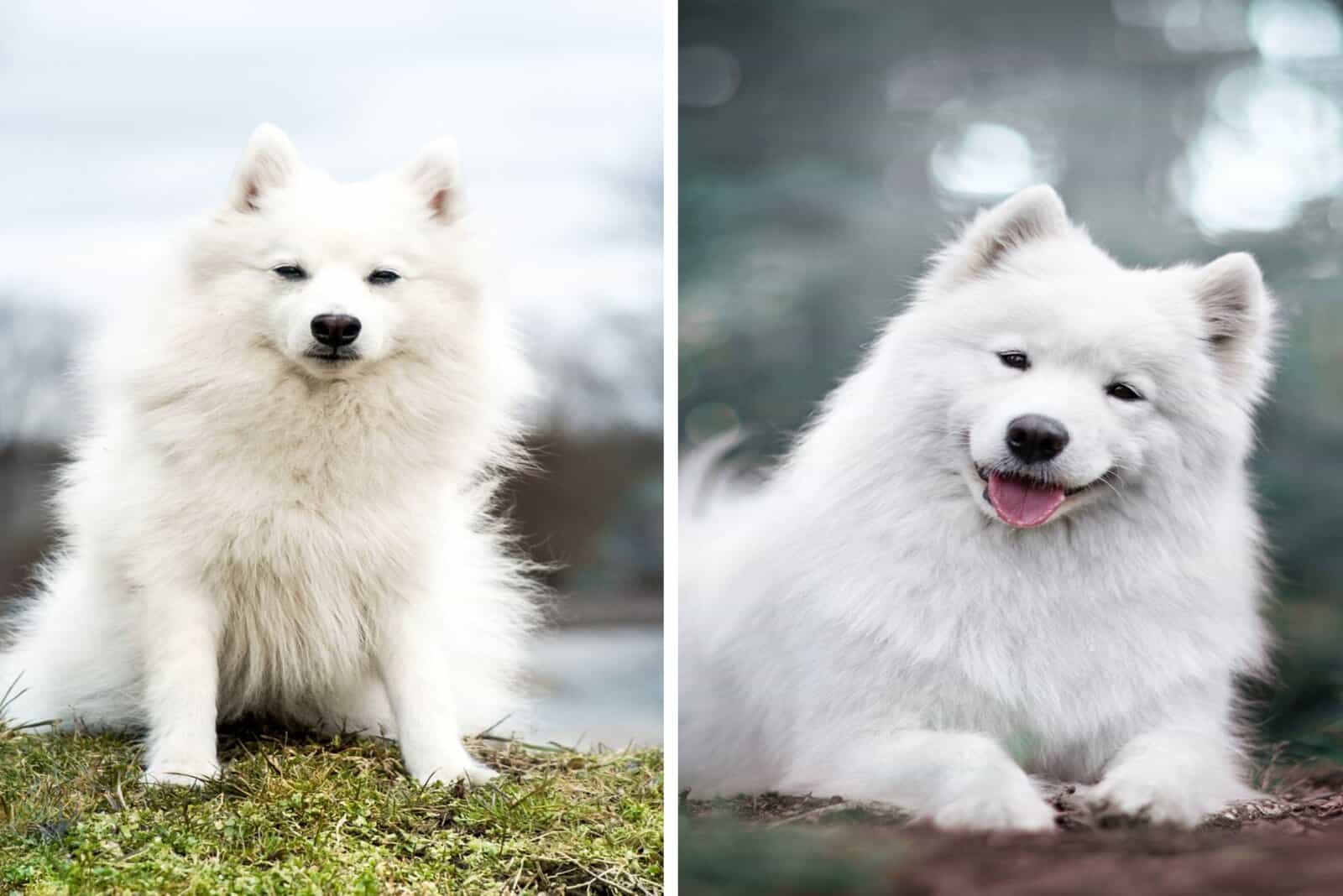
Even though Japanese Spitz and Samoyed dogs have a thick coat, their grooming needs are unexpectedly easy.
Japanese Spitz
You would think that the Japanese Spitz white coat is easy to get dirty, but that is not the case, as their coat has a specific texture that helps and mud is easily brushed out when it dries, or it just slides right off.
Beneath the fluffy outer coat, there is a thick and dry undercoat that needs to be brushed once or twice every week in order to prevent matting and knots. For this kind of coat, it is best to use pin brushes that will reach their undercoat and remove all the dead hairs, which will help you later, when shedding season comes.
Concerning shedding, the Japanese Spitz sheds their coat twice a year, for about 2 to 3 weeks, until he has shed all of his undercoat. During this period, it’s important that you brush him every day.
Bath him only once every season, unless he gets really dirty playing outside, as this way, you will protect his sensitive skin and keep his natural oils that are there to prevent itching or dryness.
Samoyed
A Samoyed will require more salon time than other dog breeds, as he sheds quite a lot. This must be the reason they call him the cloud dog or snow white.
A Samoyed requires regular brushing, which will keep the shedding situation under control, especially in spring and fall, when their shedding season comes. While Samoyeds have less reason to blow their coat in colder climates, in the warmer climates, it is necessary.
When, or if, you purchase a Sammie, also get yourself a metal comb, pin, and slicker brush, as this will help you tremendously.
Luckily, Sammies have really clean coats that you’ll only have to bathe every three months. Their white color is something special, and if you want to keep it like that, you can use a special shampoo.
Japanese Spitz Vs. Samoyed: Coat Colors
Japanese Spitz
The Japanese Spitz only comes in a white coat color.
Samoyed
By contrast, the Samoyed comes in four colors: white, biscuit, cream, and a mix of white and biscuit.
Japanese Spitz Vs. Samoyed: Diet
Japanese Spitz
The diet of your Japanese Spitz dog should be formulated just for him, a small breed with average exercise needs. They are known for not being picky about their food and enjoy fruits and vegetables as treats.
It is great if you consult with your veterinarian about the diet of your pooch, as their needs change during growth.
Samoyed
Make sure to see your veterinarian about your Samoyed’s diet, as they are sometimes prone to obesity. That’s why you need to monitor their diet, in order to see that they’re not gaining too much weight.
Be careful about that, as their thick, fluffy coat may hide that they are overweight.
Japanese Spitz Vs. Samoyed: History
Japanese Spitz
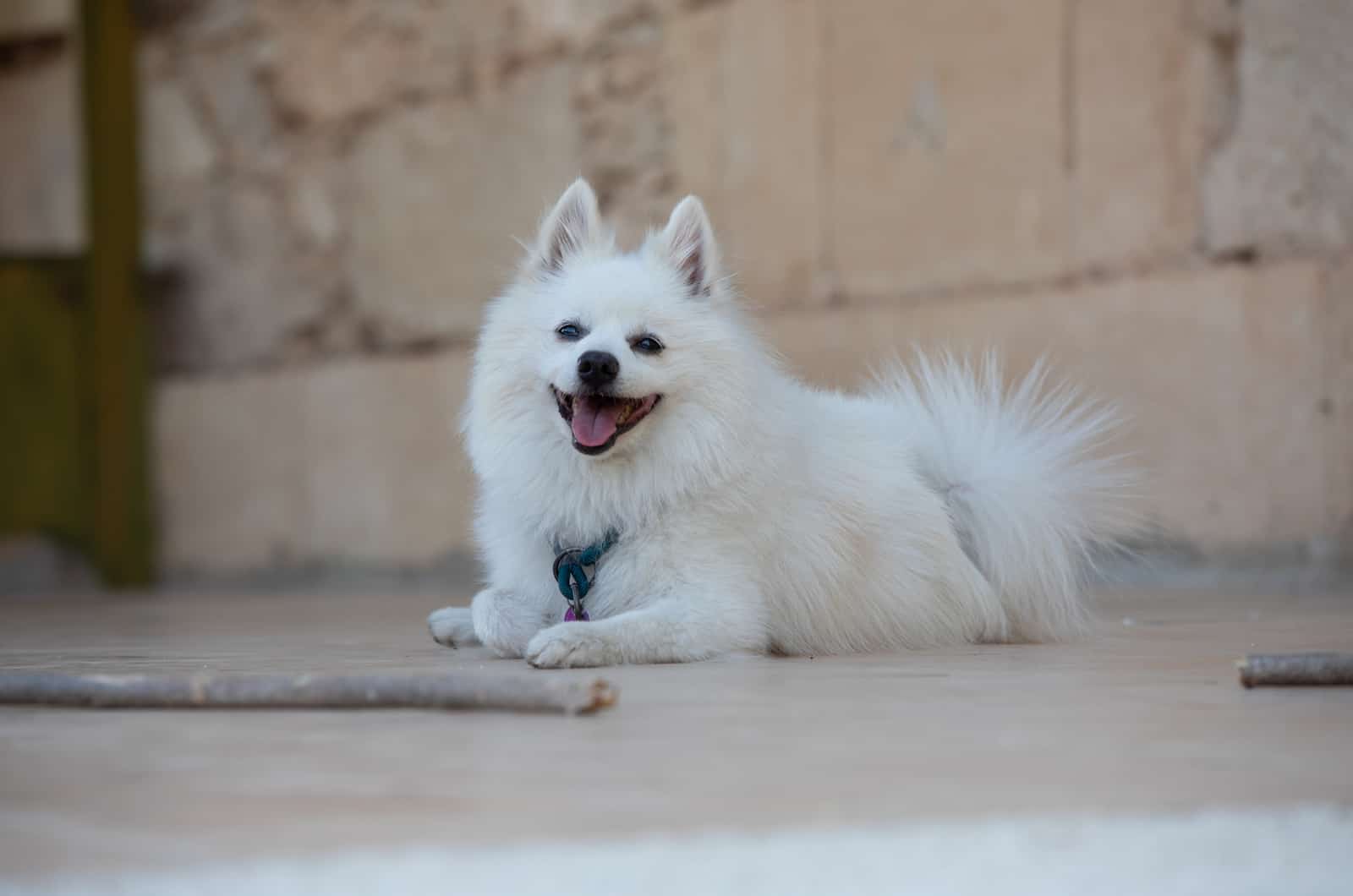
This dog breed was bred from the white German Spitz that was brought to Japan. The German Spitz is thought to be the one of the most ancient dog breeds, and after many years of crossbreeding different Spitz types, in 1948, the Japanese Spitz was classified as a white, fluffy, and petite Spitz breed.
As all Spitz breeds, a Japanese Spitz dog has a thick, double, white coat that serves him as protection from cold weather. However, on really cold days, these dogs love to be indoors around their loved ones.
The history of the Japanese Spitz breed is unknown because all records about it were destroyed in World War II.
The Japanese Kennel Club established the Japanese Spitz as a breed standard in 1948, and since then, it has become extremely popular in Japan. Later on, when this breed became recognized by the United Kingdom’s Kennel Club, it spread around the world, including to Australia, India, and the United States.
Since the 1980s, the Japanese Spitz has been prominent and accepted by many clubs, and today, the American Kennel Club is also a club that has recognized the breed.
The breed has been prominent in the U.S. since the 1980s and accepted by numerous clubs, including the International Canine Federation. Today, the Japanese spitz is recognized via the American Kennel Club’s Foundation Stock Service.
Samoyed
The Samoyed is a member of the Nordic Spitz dog group from Asia. This breed has direct ties to ancient wolves, as do other 13 breeds.
Thanks to their Siberian ancestors, the Samoyeds have natural herding instincts. People bred them to be close friends to their children, as well as great hunters and haulers.
The era known as the Heroic Age of Antarctic Exploration was the era of Samoyeds, where they, with their packs, led the way for adventurers in the late 1800s and the early 1900s. Samoyeds traveled with well-known travelers such as Robert Falcon Scot, Ernest Shackleton, and Roald Amundsen.
You won’t guess who helped popularize Sammies as show and companion dogs, Queen Alexandra of England.
How Does A Samoyed Differ From A Spitz?
We’ve prepared a comparison table for you, in order to see the breeds’ different factors in one place, if you want to choose between them.
[table id=476 /]
Is There A Smaller Version Of A Samoyed?
There is a smaller version of a Samoyed and it is called a Miniature Samoyed. They are a smaller version of a regular Samoyed.
Basically, they have many of the same traits and characters as the bigger Samoyeds but they are put in a smaller package. They are affectionate, intelligent, playful, inquisitive, and loyal dogs.
Is A Samoyed A Spitz?
Yes, a Spitz is any dog that belongs to the group of northern dogs, such as a Pomeranian, Chow Chow, and Samoyed. All of these dogs are characterized by thick long coats, erect pointed ears, and tails that curve over their backs.
In Conclusion: The Verdict
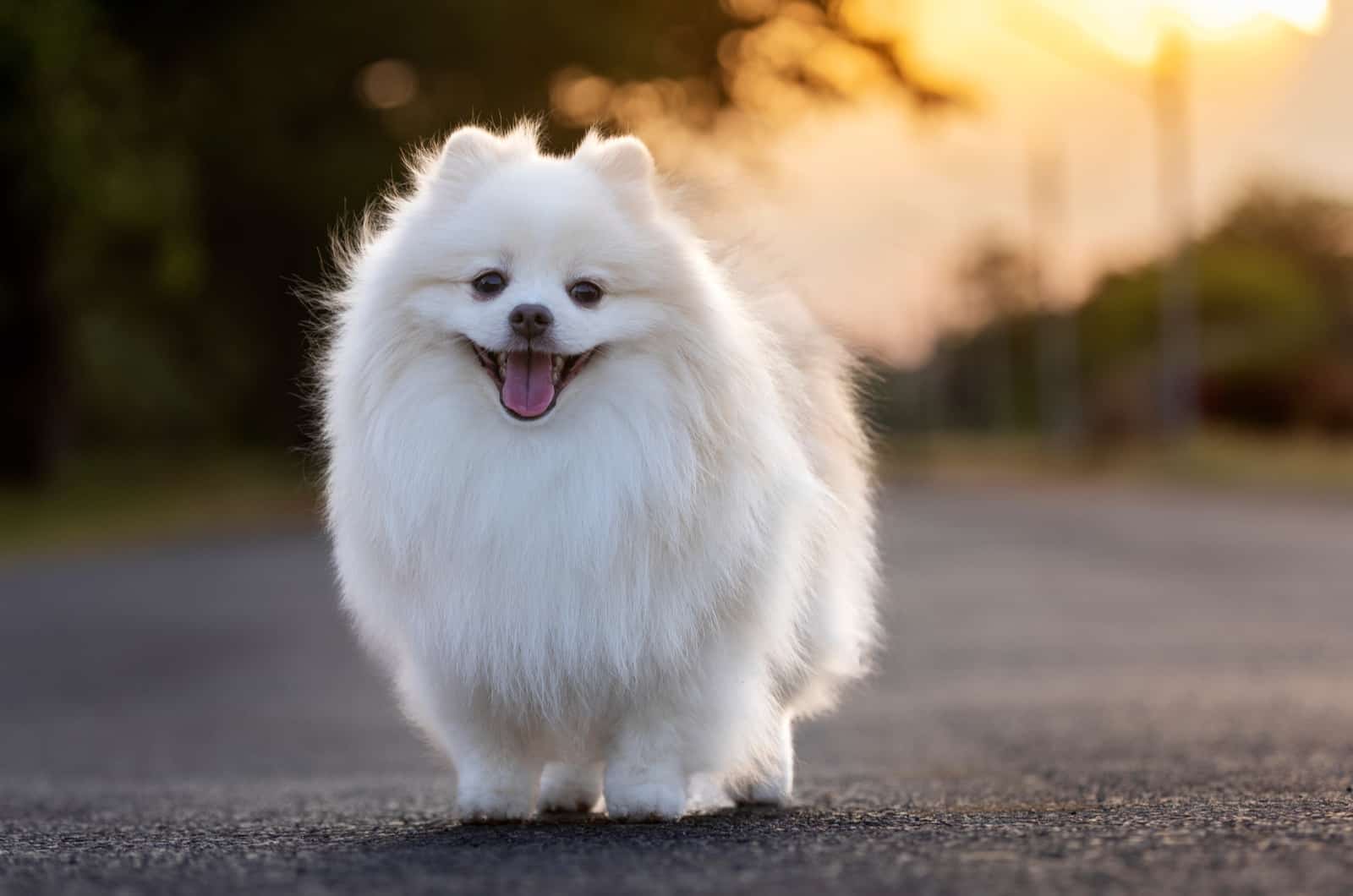
So, now we’ve compared the two breeds in our Japanese Spitz Vs. Samoyed project, which one do you think is the best dog for you?
If you consider both of the breeds adorable and desirable, which is probably the case because you wouldn’t be here if it weren’t the case, you can decide based on your living conditions.
If you live in a smaller apartment and you are not a big fan of exercising and doing outdoor activities, maybe the Japanese Spitz would be the right fit for you, as these dogs are not demanding when it comes to their daily needs and activities.
They can adapt to small places and they require just one walk per day. Just you running errands with your Spitz companion is enough to fill his exercise needs.
However, if you own a house with a big and wonderful backyard, and you enjoy running, hiking, and any outdoor activity and you are ready for challenges, the Samoyed dog breed is perfect for you.
As we said, they are those types of dogs that push you to do better. With a Samoyed, you won’t need a gym coach!
It’s always tough to choose between two dog breeds that you love the look of. Even after reading through this article, you might still have questions and doubts. But, it’s entirely up to you!
Related Articles
• Samoyed Cost: A Guide To Buying And Caring For Samoyed Dogs
• Best Samoyed Breeders – Where To Find Samoyed Puppies For Sale
• 3 Japanese Spitz Breeders In The U.S.: Rare And Precious
